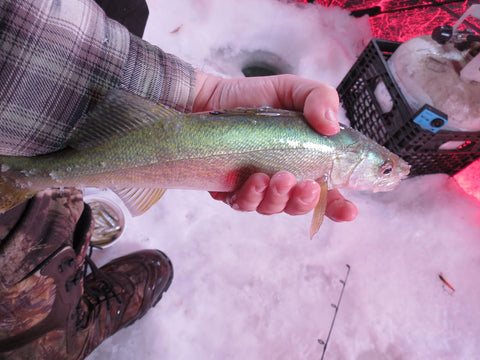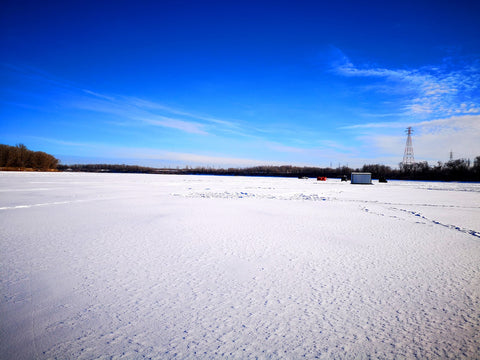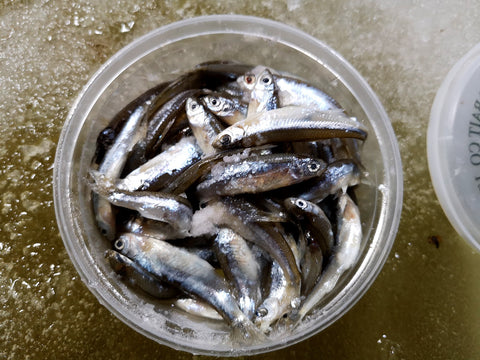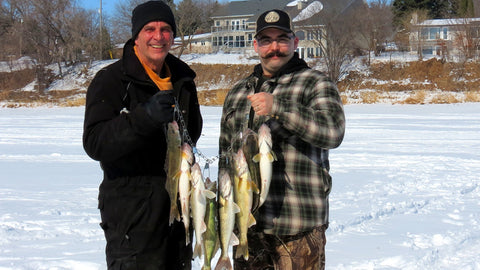Written By: Adam Zacharias
Winter has arrived in full force, and that means one thing, ice fishing! Whether you are waiting for the ice to thicken up, or are already out punching holes, you can never be too prepared. Part of that preparation involves having the right gear, and making sure you are safe on the ice.
Another part of that preparation is arming yourself with a little bit of knowledge about the fish you are targeting. Today I am here to share my 4 best pieces of advice for finding those elusive river walleye under the ice.
This is what it’s all about

Find the Depth
When you first walk or drive onto a frozen river, it sure seems like there is not much to distinguish one area from the next. Often you are looking at a flat, white, featureless scene broken only by the occasional ice fishing shelter. This is the part of the day where you need to put the most work in. Indeed, the more work you put in now, the better the rest of your day will be.
Before you ever set up your shelter, you need to find the depth you will be fishing at. This depth will obviously vary between locations depending on a host of factors such as river depth, type of bottom, available inlets and tributaries, structure, and more. If you can, reach out to local fishermen and find out what depth they have been catching at. If they are willing to share, this will be your best starting point.
Pick a starting point and start punching a line of holes. I usually start shallower and make a line towards the middle. I like to punch a hole every 15-20 yards at first, and shorten it up if I need to fine-tune things. For each hole you punch, check the depth with a flasher, weighted rope, or your fishing line. This line of holes will give you a good idea of what the bottom looks like in this area. Does it slope gradually to a middle channel? Is there a flat area that drops off sharply? Is there structure that goes up and down? This is all important information to know, just like during open water season, and will help you to decide which depth and which point on the river to set up your shelter.

Flat and featureless, it’s often hard to know where to start on a frozen river
Use Quality Bait
River walleye in particular seem to have a knack for detecting, and avoiding, bad bait. If you use live bait in your area, be sure to get it fresh and from a supplier that takes proper care of them. You don’t want sickly or scrawny looking bait. When using frozen minnows, chubs, shiners, or smelt, be sure that you look at it before you buy it. Don’t buy bait that is graying, mushy, or dried out. Somehow, the fish always know, and they turn their noses up at it more often than not.
Salted frozen minnows can be really great in this regard, both for the extra flavor that walleye seem to love, and because you can use a tub of them over multiple days. Where most frozen bait tends not to re-freeze well, salted bait can usually be re-frozen and re-used without harming the quality too much. I would not recommend re-freezing more than once though, or the minnows will get mushy.
For a bonus tip regarding salted bait, I have found that the best way to keep a partial tub of salted minnows is to drain all the water from the tub and keep it in the refrigerator. Add some extra salt if need be, or if you find they are going soft. Salted minnows should be good to use for a few days if kept this way, without the hassles that come from multiple freezings.

Good bait should be firm and brightly colored, not gray or soggy
The First 10 Seconds
From the time you drop your line in the water, the first 10 seconds is the most important. This is the time that you will often get hit hard, and if you are not expecting it you can easily lose these fish! The reason for this is simple. Having a bait drop suddenly in front of their faces will often trigger a reactionary strike. Because these strikes are instinctive, they are often more aggressive and harder hitting than other bites. However, if you aren’t holding your rod when this happens, they will quickly spit your hook out before you can set it!
The rest of the time you are fishing, you are working to entice the fish into biting. This usually involves jigging, rattling, or other methods meant to draw fish in and give them a look at your bait. Walleye are notoriously finicky biters and will sit and nibble on a minnow for a long time before they commit. During this time it is fine to have your rod in a holder, or in the snow, because you will see the nibbles and have time to pick up the rod and wait for the exact right time to set the hook.
Whenever you switch hooks, put on a new bait, or otherwise have your line out of the water for a minute or two, be sure and keep a hold of it for at least 10 seconds when you drop it back in. Don’t be too quick to set it down until you are sure that reactionary bite isn’t going to happen.

Get comfy, and hang on to that rod!
Switch it Up
You are at a good depth, you have quality bait, and you are marking fish beneath you, but nothing is biting. It’s time to switch it up. Where I fish, walleye have a reputation for being picky eaters. There are a lot of days where one specific jig color will be the only thing they bite on, and the next day they won’t even look at it. Time after time, we get set up with our tried and true lures, only to be completely skunked. Until we’ve worked through our entire tackle box and suddenly get hammered on that one jig we’ve never used before. I can’t tell you why it happens, but it happens.
So, if things are going slowly for you, or the bite dies off fairly suddenly, it could just be that they are looking for something different now. Be prepared and willing to try different things while you are ice fishing. This could be different lures, different baits, or just different colors of the same lure. It all makes a difference, and the walleye will let you know when you drop in something that they want.
It is common here for ice fishers to bring along several rods, all with different lures tied on. This is very useful when you are switching often, allowing you to keep lines in the water while you rummage through your tackle box and tie on new lures, maximizing your fishing time.

More time fishing is more time catching
In the same breath, be sure and come prepared with a variety of ice fishing lures so that you are not left hanging when the walleye decide they want something different. What better way to do that than with the Simple Fishing Elite Ice Fishing box? Check them out today and never be lacking in lure variety again.
